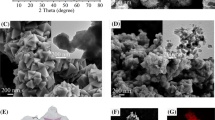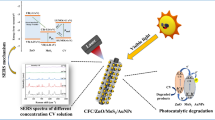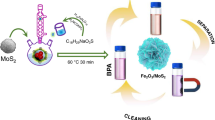Abstract
A heterojunction microcomposite was synthesized that consists of ZnO nanoparticles (ZnO NPs) anchored on MoS2 microflowers (MoS2 MFs). The material is shown to enable trace level detection of the pollutant bisphenol A (BPA). The microcomposite was characterized by XRD, XPS, SEM and TEM. In addition, coupling reaction between phenolic estrogens and Pauly’s reagents was adopted to greatly enhance the SERS signal. BPA display a characteristic Raman band at 1592 cm−1 which can be used for its selective detection. The assay is highly sensitive and has a 1 nM detection limit which is the lowest among the reported semiconductor substrates.

MoS2/ZnO MCs SERS substrate broke through the application barrier of semiconductor composite materials in SERS substrates. It also sheds light on a deeper understanding of the charge-transfer based enhancement mechanism.






Similar content being viewed by others
References
Yin D, Chen YL, Zhang YH, Yang ZC, Mao HY, Xia SG, Zhang WF, Zhao WD, Zhang SS (2018) 2D porous aromatic framework as a novel solid-phase extraction adsorbent for the determination of trace BPA in Milk. Microchim Acta 81(5):749–758. https://doi.org/10.1007/s10337-018-3504-6
Liu Y, Chen Y, Zhang YY, Kou QW, Zhang YJ, Wang YX, Chen L, Sun YT, Zhang HL, Jung YM (2018) Detection and identification of estrogen based on surface-enhanced resonance Raman scattering (SERRS). Molecules 23(6):1330. https://doi.org/10.3390/molecules23061330
Liang LP, Zhang J, Feng P, Li C, Huang YY, Dong BZ, Li LN, Guan XH (2015) Occurrence of bisphenol a in surface and drinking waters and its physicochemical removal technologies. Microchim Acta 9(1):16–38. https://doi.org/10.1007/s11783-014-0697-2
Xu JY, Li Y, Bie JX, Jiang W, Guo JJ, Luo YL, Shen F, Sun CY (2015) Colorimetric method for determination of bisphenol a based on aptamer-mediated aggregation of positively charged gold nanoparticles. Microchim Acta 182(13):2131–2138. https://doi.org/10.1007/s00604-015-1547-z
Gatidou G, Thomaidis NS, Stasinakis AS, Lekkas TD (2007) Simultaneous determination of the endocrine disrupting compounds nonylphenol, nonylphenol ethoxylates, triclosan and bisphenol a in wastewater and sewage sludge by gas chromatography-mass spectrometry. J Chromatogr A 1138(1):32–41. https://doi.org/10.1016/j.chroma.2006.10.037
Wu XQ, Wang XY, Lu WH, Wang XR, Li JH, You HY, Xiong H, Chen LX (2016) Water-compatible temperature and magnetic dual-responsive molecularly imprinted polymers for recognition and extraction of bisphenol a. J Chromatogr A 1435(26):30–38. https://doi.org/10.1016/j.chroma.2016.01.040
Shorie M, Kumar V, Kaur H, Singh K, Tomer VK, Sabherwal P (2018) Plasmonic DNA hotspots made from tungsten disulfide nanosheets and gold nanoparticles for ultrasensitive aptamer-based SERS detection of myoglobin. Microchim Acta 185:158. https://doi.org/10.1007/s00604-018-2705-x
Qian Y, Wang YQ, Mei RC, Yin YC, You JM, Chen LX (2019) Polystyrene encapsulated SERS tags as promising standard tools: simple and universal in synthesis, highly sensitive and Ultrastable for bioimaging. Anal Chem 91(8):5270–5277. https://doi.org/10.1021/acs.analchem.9b00038
Wang YQ, Yan B, Chen LX (2013) SERS tags: novel optical Nanoprobes for bioanalysis. Chem Rev 113(3):1391–1428. https://doi.org/10.1021/cr300120g
Ren XH, Cheshari EC, Qi JY, Li X (2018) Silver microspheres coated with a molecularly imprinted polymer as a SERS substrate for sensitive detection of bisphenol a. Microchim Acta 185(4):242. https://doi.org/10.1007/s00604-018-2772-z
Wang XT, Shi WX, Wang SX, Zhao HW, Lin J, Yang Z, Chen M, Guo L (2019) Two-Dimensional Amorphous TiO2 Nanosheets Enabling High-Efficiency Photoinduced Charge Transfer for Excellent SERS Activity. J Am Chem Soc 141(14):5856–5862. https://doi.org/10.1021/jacs.9b00029
Noh T, Shin HS, Seo C, Kim JY, Youn J, Kim J, Lee KS, Joo J (2019) Significant enhancement of photoresponsive characteristics and mobility of MoS2-based transistors through hybridization with perovskite CsPbBr3 quantum dots. Microchim Acta 12:405–412. https://doi.org/10.1007/s12274-018-2230-6
Wu W, Wang L, Li Y, Zhang F, Lin L, Niu S, Chenet D, Zhang X, Hao Y, Heinz TF, Hone J, Wang ZL (2014) Piezoelectricity of single-atomic-layer MoS2 for energy conversion and piezotronics. Nature 514(7523):470–474. https://doi.org/10.1038/nature13792
Vilian ATE, Dinesh B, Kang SM, Krishnan M, Huh YS, Han YK (2019) Recent advances in molybdenum disulfide-based electrode materials for electroanalytical applications. Microchim Acta 186(3):203. https://doi.org/10.1007/s00604-019-3287-y
Zhao XF, Yu J, Zhang ZJ, Li CH, Li Z, Jiang SZ, Pan J, Liu AH, Zhang C, Man BY (2018) Heterogeneous and cross-distributed metal structure hybridized with MoS2 as high-performance flexible SERS substrate. Opt Express 26(18):23831–23843. https://doi.org/10.1364/OE.26.023831
Yao JC, Quan YN, Gao M, Gao RX, Chen L, Liu Y, Lang JH, Shen H, Zhang YJ, Yang LL, Yang JH (2019) AgNPs decorated mg-doped ZnO Heterostructure with dramatic SERS activity for trace detection food contaminants. J Mater Chem C 7:8199–8208. https://doi.org/10.1039/C8TC06588H
Nur HH, Shanmugam S, Mutharasu D, Abdul RI (2016) Structural and surface characterization of undoped ZnO and cu doped ZnO using sol–gel spin coating method. Microchim Acta 27(4):3520–3530. https://doi.org/10.1007/s10854-015-4187-5
Gao M, Yan C, Li BZ, Zhou LJ, Yao JC, Zhang YJ, Liu HL, Cao LH, Cao YT, Yang JH, Wang YX (2017) Strong red emission and catalytic properties of ZnO by adding Eu2O3 shell. J Alloys Compd 724(15):537–542. https://doi.org/10.1016/j.jallcom.2017.07.060
Islam SE, Hang DR, Chen CH, Sharma KH (2018) Facile and cost-efficient synthesis of quasi 0D/2D ZnO/MoS2 nanocomposites for highly enhanced visible-light-driven photocatalytic degradation of organic pollutants and antibiotic. Chemistry 24(37):9305–9315. https://doi.org/10.1002/chem.201801397
Kibsgaard J, Chen Z, Reinecke BN, Jaramillo TF (2012) Engineering the surface structure of MoS2 to preferentially expose active edge sites for electrocatalysis. Nat Mater 11(11):963–969. https://doi.org/10.1038/nmat3439
Gao M, Yao JC, Yan C, Li XF, Hu TJ, Chen L, Wang YX, Zhang YJ, Liu HL, Liu Y, Cao LH, Cao YT, Yang JH (2017) Novel composite nanomaterials with superior thermal and pressurestability for potential LED applications. J Alloys Compd 734(15):282–289. https://doi.org/10.1016/j.jallcom.2017.11.042
Zheng ZH, Cong S, Gong W, Xuan J, Li G, Lu W, Geng F, Zhao Z (2017) Semiconductor SERS enhancement enabled by oxygen incorporation. Nat Commun 8(1):1993. https://doi.org/10.1038/s41467-017-02166-z
Tan YH, Yu K, Li JZ, Fu H, Zhu ZQ (2014) MoS2@ZnO nano-heterojunctions with enhanced photocatalysis and field emission properties. J Appl Phys 116(6):064305. https://doi.org/10.1063/1.4893020
Bang S, Lee S, Ko Y, Park J, Shin S, Seo H, Jeon H (2012) Photocurrent detection of chemically tuned hierarchical ZnO nanostructures grown on seed layers formed by atomic layer deposition. Nanoscale Res Lett 7(1):290. https://doi.org/10.1186/1556-276X-7-290
Marks HL, Pishko MV, Jackson GW, Cote GL (2014) Rational design of a bisphenol a aptamer selective surface enhanced raman scattering nanoprobe. Anal Chem 86(23):11614–11619. https://doi.org/10.1021/ac502541v
Moeinian A, Gür FN, Gonzalez-Torres J, Zhou LS, Murugesan VD, Dashtestani AD, Guo H, Schmidt TL, Strehle S (2019) Highly localized SERS measurements using single silicon nanowires decorated with DNA origami-based SERS probe. Nano Lett 19(2):1061–1066. https://doi.org/10.1021/acs.nanolett.8b04355
Yao JC, Quan YN, Gao RX, Li J, Chen L, Liu Y, Lang JH, Shen H, Wang YY, Yang JH, Gao M (2019) Improved charge-transfer and hot spots by doping and modulating semiconductor structure: a high sensitivity and renewability SERS substrate. Langmuir 35:8921–8926. https://doi.org/10.1021/acs.langmuir.9b00754
Mei RC, Wang YQ, Liu WH, Chen LX (2018) Lipid bilayer-enabled synthesis of waxberry-like Core/fluidic satellite nanoparticles: toward ultrasensitive SERS tags for bioimaging. ACS Appl Mater Interfaces 10(28):23605–23616. https://doi.org/10.1021/acsami.8b06253
Balčytis A, Nishijima Y, Krishnamoorthy S, Kuchmizhak A, Stoddart PR, Petruškevičius R, Juodkazis S (2018) From fundamental toward applied SERS: shared principles and divergent approaches. Adv Opt Mater 6(16):1800292. https://doi.org/10.1002/adom.201800292
Zhang XY, Han DL, Ma N, Gao RX, Zhu AN, Guo S, Zhang YJ, Wang YX, Yang JH, Chen L (2018) Carrier density-dependent localized surface Plasmon resonance and charge transfer observed by controllable semiconductor content. J Phys Chem Lett 9(20):6047–6051. https://doi.org/10.1021/acs.jpclett.8b02416
Gao RX, Zhang YJ, Zhang F, Guo S, Wang YX, Chen L, Yang JH (2018) SERS polarization-dependent effects for an ordered 3D Plasmonic tilted silver Nanorod array. Nanoscale 10:8106–8114. https://doi.org/10.1039/C8NR01198B
Zhang YJ, Sun HH, Gao RX, Zhang F, Zhu AN, Chen L, Wang YX (2018) Facile SERS-active chip (PS@ag/SiO2/ag) for the determination of HCC biomarker. Sensors Actuators B Chem 272(1):34–42. https://doi.org/10.1016/j.snb.2018.05.139
Yang LY, Fu CC, Wang HL, Xu SP, Xu WQ (2016) Aptamer-based surface-enhanced Raman scattering (SERS) sensor for thrombin based on supramolecular recognition, oriented assembly, and local field coupling. Microchim Acta 409(1):235–242. https://doi.org/10.1007/s00216-016-9992z
Ling X, Fang W, Lee YH, Araujo PT, Zhang X, Rodriguez-Nieva JF, Lin Y, Zhang J, Kong J, Dresselhaus MS (2014) Raman enhancement effect on two-dimensional layered materials: graphene, h-BN and MoS2. Nano Lett 14(6):3033–3040. https://doi.org/10.1021/nl404610c
Acknowledgements
This work is supported by the National Natural Science Foundation of China (No. 61675090, 61575080, 61705020 and 21676115); National Youth Program Foundation of China (No. 61405072, 21546013, 61704065, 61705078 and 51609100); Program for the development of Science and Technology Jilin province (Grant Numbers 20160101287JC and 20150519024JH); and Technology of Education Department of Jilin Province (Grant Number JJKH20170374KJ).
Author information
Authors and Affiliations
Corresponding author
Ethics declarations
The author(s) declare that they have no competing interests.
Additional information
Publisher’s note
Springer Nature remains neutral with regard to jurisdictional claims in published maps and institutional affiliations.
Rights and permissions
About this article
Cite this article
Quan, Y., Yao, J., Yang, S. et al. ZnO nanoparticles on MoS2 microflowers for ultrasensitive SERS detection of bisphenol A. Microchim Acta 186, 593 (2019). https://doi.org/10.1007/s00604-019-3702-4
Received:
Accepted:
Published:
DOI: https://doi.org/10.1007/s00604-019-3702-4




